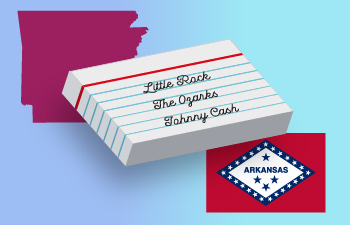Ever since Arkansas’s humble beginnings, it has been known for its nature. After all, the first settlement was created to sell furs because of the large wildlife population. Now, Arkansas is known as the Natural State, and rightly so: over half of the state is covered in forests! Even the name of the state comes from the Native American word “acansa,” meaning “a downstream place.”
Discover more about the history and geography of the Natural State in this homeschool unit study supplement. This is part of Time4Learning’s full series of United States unit study supplements. You can also download our list of PreK-12 interactive activities that align with your study of interesting facts about Arkansas.
Arkansas Fast Facts
| Became a State | June 15, 1836 |
|---|---|
| Order it Joined the Union | 25th state |
| State Capital | Little Rock |
| State Abbreviation | AR |
| Border States | |
| State Flag |  |
| State Song | |
| State Flower | Apple Blossom |
| State Nicknames |
|
| Notable Arkansans |
|
Historical Facts About Arkansas
Long before Arkansas became a state, there was a group of people called the Bluff Dwellers who lived in caves in the Ozark Mountains. Those Bluff Dwellers were the first settlers to arrive in Arkansas, and were soon joined by other Native American tribes.
However, the land remained rather undeveloped until the 1600s, when European settlers found the land. Frenchman Henri de Tonty built the Arkansas Post in 1686, which was the first true European settlement. The post was used for many years as a base for fur trappers, and was also developed as farm land.
In 1803, Arkansas first encountered the United States through the Louisiana Purchase. This decision made by Thomas Jefferson gave the United States lots of land, including Arkansas and Louisiana, that was bought from the French.
After the purchase, Arkansas was part of the Mississippi Territory, and the Arkansas Post was considered the capital. In 1819, Arkansas became its own territory, and the capital was moved to its current location in Little Rock in 1821. As the territory grew and became developed, the Natural State was admitted to the Union on June 15, 1836 under President Andrew Jackson.
Arkansas was a slave state when first admitted to the Union, and joined the Confederacy when Civil War broke out. The state rejoined the Union in 1868 under President Andrew Johnson, but was damaged by the war. Arkansas remained in economic shambles until the late 1800s, when timber and mining industries became popular.
In the 1950s, Arkansas became a major component of the Civil Rights Movement. The state received attention from President Eisenhower when nine black students tried to attend an all-white school in 1957. The president sent U.S. troops to Little Rock, where the school was located, to make sure the students could attend.
In the timeline below, your homeschooler will get a better understanding of Arkansas’s history and learn interesting facts about Arkansas as well.
Arkansas Timeline
12,000 B.C.
Inhabited by Bluff Dwellers.
1541
First explored by Hernando de Soto, a Spanish explorer.
1681
First settled by Frenchman Henri de Tonti, who created the Arkansas Post. Tonti is considered the “Father of Arkansas”.
1803
Arkansas is bought by the United States as part of the Louisiana Purchase, which cost $15,000,000.
1819
U.S. Congress establishes the Arkansas Territory, separating it from Louisiana .
1821
The capital is created in the town of Little Rock, due to the road that runs from Little Rock to Memphis.
1836
Joined Union, becoming the 25th U.S. state. The state flag has 25 stars to symbolize this.
1861
Civil War begins, and Arkansas secedes from the Union. 25% of the population were slaves at this time.
1868
Arkansas is readmitted to the Union. Carpetbaggers from the North take advantage of the South, making it difficult for them to rebuild their economy.
1876
Two Arkansas newspaper editors from the same town had a street fight to settle their differences. The loser of the fight sold his paper and left town.
1906
Diamonds are first discovered in Arkansas by John Huddleston.
1957
The Little Rock Nine were the nine black children who tried to attend an all-white school. The governor of Arkansas, Orval Faubus, called the Arkansas National Guard to prevent the students from going. President Eisenhower had to send the U.S. army to escort the children into the school.
1962
The first ever Walmart was opened by Sam Walton.
1978
Bill Clinton is elected Governor of Arkansas.
Bring history and geography to life with Time4Learning’s interactive online social studies curriculum for grades 2-12.
Geographical Facts About Arkansas
Can you locate Arkansas on this printable map of America? Arkansas is home to plenty of natural areas, with a wide range of landscapes to explore. The name of the state actually comes from the word “acansa,” which means “a downstream place.” There are over 600,000 acres of lakes, and 9,700 miles of streams in the state!
These are just some of the interesting facts about the Natural State’s geography that your homeschooler will find interesting. To enhance your unit study supplement, explore a map of the state then download our printable Arkansas map below and mark it up with your child. Here are some facts you and your homeschooler may want to note about Arkansas’s geography and its unique features.
- The Natural State has that name for a reason: there are six national parks, 2,500,000 acres of national forests, seven national scenic byways, three state scenic byways, and 50 state parks.
- Arkansas has the only active diamond mine in the U.S., and the only park where you can hunt for diamonds yourself! It’s called Crater of Diamonds State Park, about 100 miles southwest of Little Rock.
- Little Rock is located right in the center of Arkansas, which offers plenty ease of access to travel to other cities. It is about 125 miles west of Memphis, TN.
- The lowest elevation in Arkansas is 54 feet above sea level at the Quachita River, while the highest point is Mount Magazine, which has an elevation of 2,753 feet.
- The Ozark National Forest, which is about 130 miles northwest of Little Rock, covers over one million acres of land.
- In fact, more than half of the state of Arkansas is covered by forestland.
- There are 47 hot springs that average 143 degrees that are from Hot Springs Mountain, about 50 miles southwest of Little Rock.
- Alma, near the Arkansas-Oklahoma border, claims to be the Spinach Capital of the World.
- The Dover Lights are lights that overlook the Ozark Valley, and appear in different colors. It’s an unexplained phenomenon, but some people believe that the lights belong to the ghosts of Spanish Conquistadors searching for gold. Dover is just 5 miles south of the Ozark Mountains.
- The Boggy Creek Monster, a reported Bigfoot wannabe, supposedly kills livestock. His home is in Fouke, about 150 miles southwest of Little Rock.
Arkansas State Map
Download our FREE Arkansas state map printable. Use it as a coloring page or use it to plot the state’s geographical features.
Activities for Children in Arkansas
Whether you are a homeschooler in Arkansas, or just a family who is planning a trip to the Natural State in the near future, you should be aware of some of the educational destinations in the state. Enhance your Arkansas state facts study with these homeschool field trip ideas.
- Crater of Diamonds State Park (Murfreesboro) – Experience the only “keep what you find” diamond site in the entire world! Search through a plowed 37.5 acre field, the eighth largest in the world. $10 or less per ticket, depending on age, and tickets are good for the whole day.
- Scott Plantation Settlement (Scott) – There are 26 exhibits at this historic plantation museum. Tickets are inexpensive and the tours last for about an hour. Come see the restored train station, a plantation owner’s home, a working blacksmith shop, and more.
- Arkansas Frontier (Quitman) – Learn about early farm life, and hear about the historic settlers who first arrived to Arkansas. This pumpkin patch offers more than just fun – it also provides education that is engaging and interesting to all ages.
- Turpentine Creek (Eureka Springs) – Take a guided habitat tour, or explore the Discovery Area! This Wildlife Refuge offers lots to see, and features experienced zoology and biology experts. Tours are an hour, but there is also plenty to see by yourself.
- Reynolds Science Center Planetarium (Arkadelphia) – If your homeschooler is interested in experiences out of this world, look no further than this planetarium! At such a low cost, there are plenty of options, including public shows and star gazing events. It is also located inside of the Reynolds Science Center, which has exhibits of its own to explore.
Arkansas Freebies and Deals for Homeschoolers
- The Walmart Museum (Bentonville) – Curious to see the very first Walmart ever created? Look no further than the Walmart Museum. Tours are self-guided and offer education about the history of Walmart and its mission. There is also a Spark Cafe Soda Fountain!
- Clinton Presidential Center (Little Rock) – The Clinton Center, over 22,000 square feet, offers an educational experience. Your homeschooler can learn about presidential life, and the accomplishments of Bill Clinton. Homeschool groups are free, but a reservation must be made. There are also free admission days.
- The Arts & Science Center for Southeast Arkansas (Pine Bluff) – There’s so much to see at this free museum! There’s Arkansas art, art of the Delta, and lots of different science exhibitions. The exhibits are rotating, so be sure to check the website before you go.
- Hot Springs National Park (Hot Springs) – This is one of very few national parks in the U.S, that is free to visit! There is plenty to see or do, both inside and outside. For the adventurers, there are plenty of hiking trails, and you can find historic bath houses indoors as well.
Arkansas Learning Games for Children
Take your kid’s online learning experience a bit further with these free resources to assess your child’s knowledge about Arkansas historical and geographical facts and learn even more about the Badger State.












